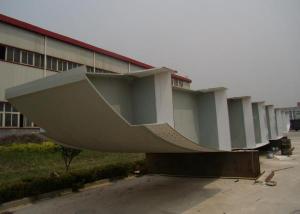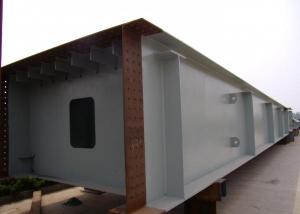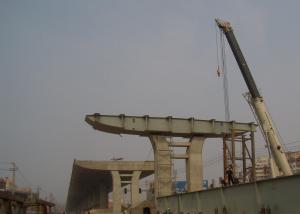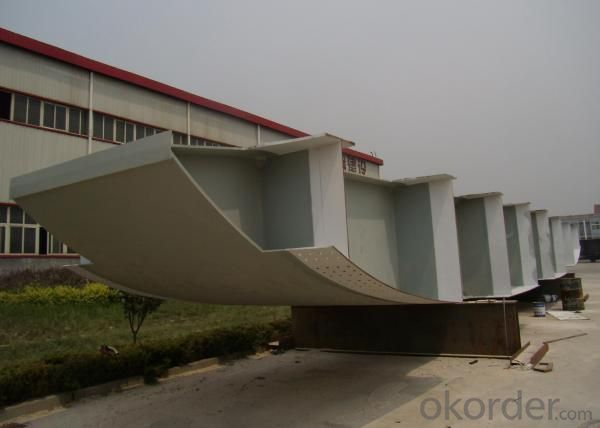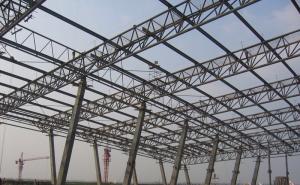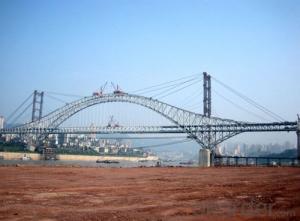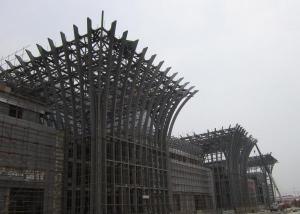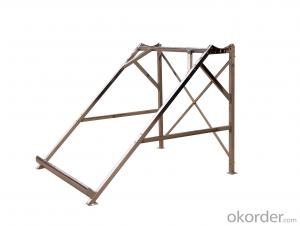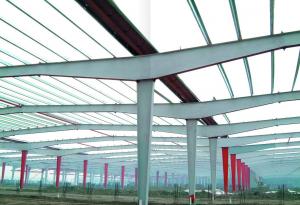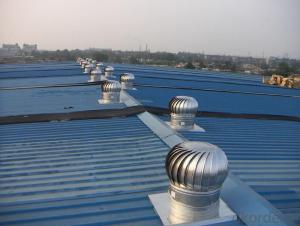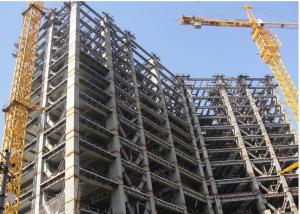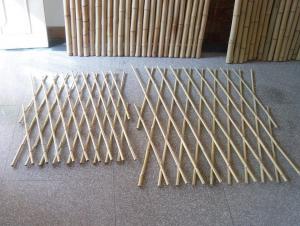Viaduct Bridge Steel Structure
- Loading Port:
- Tianjin Port
- Payment Terms:
- TT or LC
- Min Order Qty:
- 1000MTONS m.t.
- Supply Capability:
- 5000MTONS/MONTH m.t./month
OKorder Service Pledge
OKorder Financial Service
You Might Also Like
Specifications of viaduct bridge steel structure
Project type: main street viaduct steel structure
The steel dosage: 2760MTs
Building area: 1116M2
The unit component weight: 25.6MTs
Bridge wide: 24M
The long span: 30-35m
Viaduct is from the West Second Ring Road to East Second Ring Road, a total length of 11.55 kilometers, the bridge 24 meters wide, two-way six-lane
1. GB standard material
2. High Structural safety and reliability
3. The production can reach GB/JIS/ISO/ASME standard
Packaging & Delivery of viaduct bridge steel structure
1. According to the project design and the component size, usually the main component parts are nude packing and shipped by bulk vessel. And the small parts are packed in box or suitable packages and shipped by containers.
2. This will be communicated and negotiated with buyer according to the design.
Engineering Design Software of viaduct bridge steel structure
Tekla Structure \ AUTO CAD \ PKPM software etc
⊙Complex spatial structure project detailed design
⊙Construct 3D-model and structure analysis. ensure the accuracy of the workshop drawings
⊙Steel structure detail ,project management, automatic Shop Drawing, BOM table automatic generation system.
⊙Control the whole structure design process, we can obtain higher efficiency and better results
Technical support of viaduct bridge steel structure
|
Worker |
Rate of frontline workers with certificate on duty reaches 100% |
|
Welder |
186 welders got AWS & ASME qualification 124 welders got JIS qualification 56 welders got DNV &BV qualification |
|
Technical inspector |
40 inspectors with UT 2 certificate 10 inspectors with RT 2 certificate 12 inspectors with MT 2 certificate 3 inspectors with UT3 certificate |
|
Engineer |
21 engineers with senior title 49 engineers with medium title 70 engineers with primary title. 61 First-Class Construction Engineers 182 Second-Class Construction Engineers |
|
International certification |
10 engineers with International Welding engineer, 8 engineers with CWI. |
Production Flow of steel structure
Material preparation—cutting—fitting up—welding—component correction—rust removal—paint coating—packing—to storage and transportation (each process has the relevant inspection)
steel structure square column production line steel structure component fitting-up machine
Usage/Applications of steel structure
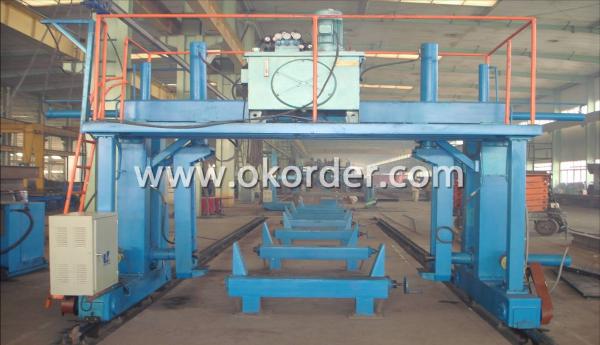
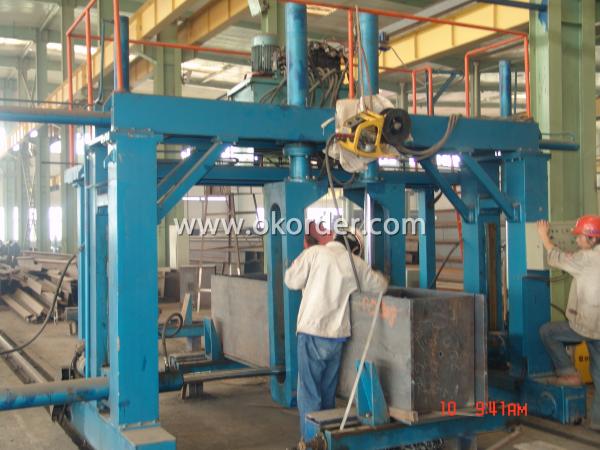
*Characters of Structure Steel
1. Steel is characterized by high strength, light weight, good rigidity, strong deformation capacity, so it is suitable for construction of large-span, super high and super-heavy buildings particularly;
2. It with good homogeneous and isotropic, is an ideal elastomer which perfectly fits the application of general engineering;
3. The material has good ductility and toughness, so it can have large deformation and it can well withstand dynamic loads;
4. Steel structure’s construction period is short;
5. Steel structure has high degree of industrialization and can realize-specialized production with high level of mechanization.
*Steel structure application
1. Heavy industrial plants: relatively large span and column spacing; with a heavy duty crane or large-tonnage cranes; or plants with 2 to 3 layers cranes; as well as some high-temperature workshop should adopt steel crane beams, steel components, steel roof, steel columns, etc. up to the whole structure.
2. Large span structure: the greater the span of the structure, the more significant economic benefits will have by reducing the weight of the structure
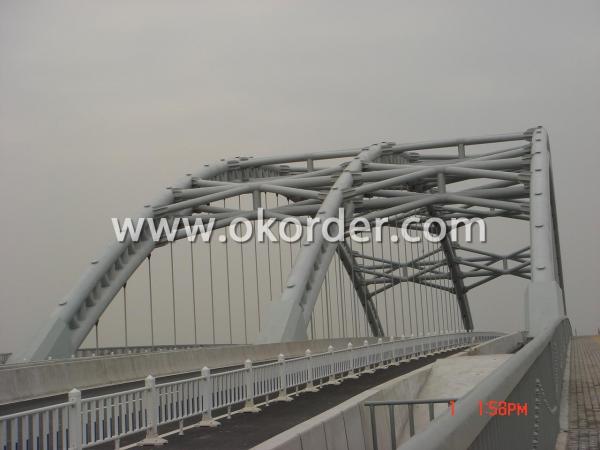
3. Towering structures and high-rise buildings: the towering structure, including high-voltage transmission line towers, substation structure, radio and television emission towers and masts, etc. These structures are mainly exposed to the wind load. Besides of its light weight and easy installation, structure steel can bring upon with more economic returns by reducing the wind load through its high-strength and smaller member section.
4. Structure under dynamic loads: As steel with good dynamic performance and toughness, so it can be used directly to crane beam bearing a greater or larger span bridge crane
5. Removable and mobile structures: Structure Steel can also apply to movable Exhibition hall and prefabricated house etc by virtue of its light weight, bolt connection, easy installation and uninstallation. In case of construction machinery, it is a must to use structure steel so as to reduce the structural weight.
6. Containers and pipes: the high-pressure pipe and pipeline, gas tank and boiler are all made of steel for the sake of its high strength and leakproofness
7. Light steel structure: light steel structures and portal frame structure combined with single angle or thin-walled structural steel with the advantages of light weight, build fast and steel saving etc., in recent years has been widely used.
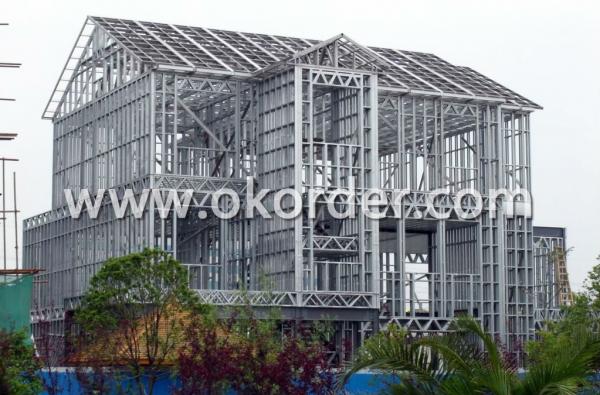
8. Other buildings: Transport Corridor, trestle and various pipeline support frame, as well as blast furnaces and boilers frameworks are usually made of steel structure.
All in all, according to the reality, structure steel is widely used for high, large, heavy and light construction.
- Q: How is steel used in residential structures?
- Steel is commonly used in residential structures for its strength and durability. It can be used in various ways, such as in the construction of beams, columns, and frames. Steel beams are often used to support the weight of floors, walls, and roofs, providing stability and ensuring the structural integrity of the building. These beams can span longer distances without the need for additional support, allowing for more open floor plans and flexible room layouts. Steel columns are used to support the vertical load of the structure, transferring it to the foundation. They are often used in conjunction with steel beams to create a strong and stable framework. Steel frames, consisting of beams and columns, provide the skeleton of the residential structure, supporting the weight of the building and resisting various forces such as wind and earthquakes. In addition to its strength, steel is also fire-resistant, making it a safe choice for residential structures. It is less likely to warp, rot, or be damaged by pests compared to traditional building materials like wood. Steel is also highly recyclable, making it an environmentally friendly option. Moreover, steel can be easily fabricated and customized to fit specific design requirements, allowing for innovative and unique architectural designs. Its versatility makes it an ideal choice for residential structures, as it can be used in various applications, including walls, roofs, and even entire prefabricated modular units. Overall, steel offers numerous advantages for residential structures, including strength, durability, fire resistance, and design flexibility. Its extensive use in construction has proven to be beneficial in creating safe, long-lasting, and aesthetically pleasing homes.
- Q: How are steel structures used in the construction of offshore platforms?
- Steel structures are widely used in the construction of offshore platforms due to their exceptional strength, durability, and resistance to harsh marine environments. These structures provide the necessary support and stability for drilling operations, production facilities, and living quarters on offshore platforms. Steel is used to create the framework, decks, and beams of the platforms, ensuring their ability to withstand the dynamic loads, extreme weather conditions, and unpredictable movements of the ocean. Additionally, steel structures can be easily fabricated, transported, and assembled, making them a cost-effective solution for offshore construction projects.
- Q: How are steel structures used in wastewater treatment plants?
- Steel structures are commonly used in wastewater treatment plants for their durability, strength, and corrosion resistance. They are used to construct various components such as tanks, pipelines, and supports for equipment. The steel structures provide stability and longevity, ensuring efficient and reliable operations in wastewater treatment processes.
- Q: What are the maintenance requirements for steel structures?
- The maintenance requirements for steel structures include regular inspections for signs of corrosion or structural damage, cleaning to remove dirt and debris, and applying protective coatings to prevent rusting. Additionally, any necessary repairs or replacements should be promptly addressed to ensure the structural integrity of the steel.
- Q: How are steel structures used in cold storage facilities?
- Steel structures are commonly used in cold storage facilities due to their strength, durability, and ability to withstand extreme temperatures. Steel is used to construct the framework, walls, and roof of these facilities, providing a stable and secure structure to support the storage of perishable goods at low temperatures. Additionally, steel structures allow for efficient insulation and the installation of refrigeration systems, ensuring that the cold storage facility maintains the required temperature levels for preserving the integrity and quality of the stored products.
- Q: What are the advantages of using steel as a construction material for building structures?
- Steel offers numerous benefits as a construction material for building structures. First and foremost, its exceptional strength and durability make it an ideal choice. With a high strength-to-weight ratio, steel can endure heavy loads without buckling or collapsing, making it suitable for tall and large buildings, bridges, and other structures requiring robustness. Additionally, steel exhibits high resistance to various environmental factors. Unlike wood or other organic materials, it is impervious to rot, termites, and mold. Moreover, steel is fire-resistant, enhancing building safety by slowing down fire spread and allowing more time for evacuation. Another advantage of steel lies in its design versatility. It can be effortlessly molded and shaped into diverse forms, enabling architects and engineers to create intricate and distinctive structures. Moreover, steel can be prefabricated off-site and assembled on-site, reducing construction time and labor costs. Furthermore, steel is a sustainable and eco-friendly material. It is 100% recyclable, meaning it can be reused without compromising its properties, resulting in reduced waste and conservation of natural resources. Additionally, the energy required for steel production has considerably decreased over time, making it a more energy-efficient option compared to other construction materials. Moreover, steel structures are renowned for their longevity. Steel has a long lifespan and necessitates minimal maintenance. It does not warp, crack, or shrink over time, ensuring the structural stability of the building for decades. Consequently, frequent repairs or replacements are unnecessary, saving both time and money in the long run. In conclusion, the advantages of using steel as a construction material for building structures encompass its strength, durability, resistance to environmental factors, design versatility, sustainability, and longevity. These attributes make steel an excellent choice for a wide array of construction projects, offering safety, efficiency, and cost-effectiveness.
- Q: What does the horizontal support of steel structure mean?
- Horizontal support generally means that the support system is parallel to the ground and opposite to the vertical support. A vertical support means that the plane formed by the system is perpendicular to the ground or perpendicular to the plane in which the roof is located.
- Q: What are the different types of steel walls used in construction?
- There are several types of steel walls commonly used in construction, including stud walls, curtain walls, and structural steel walls. Stud walls consist of a steel frame with insulation between the studs, and are typically used for interior partitions. Curtain walls are non-load bearing walls made of steel frames and glass panels, often used on the exterior of buildings to provide aesthetic appeal and natural light. Structural steel walls are load-bearing walls that support the weight of the structure, and are made of steel columns and beams. These walls are essential for the overall stability and strength of the building.
- Q: What is the role of steel in food processing facilities?
- The role of steel in food processing facilities is multifaceted and crucial to ensuring food safety and hygiene. Steel is the preferred material for constructing equipment, machinery, and infrastructure in these facilities due to its unique properties and advantages. First and foremost, steel is highly durable and resistant to corrosion, making it ideal for the harsh and often corrosive environments found in food processing facilities. It can withstand frequent cleaning and sanitization procedures, exposure to water, chemicals, and high humidity levels without deteriorating or contaminating the food. Steel also offers a smooth and non-porous surface, preventing the accumulation of bacteria, dirt, and other contaminants. This characteristic is vital for maintaining the highest standards of hygiene and preventing the growth of harmful microorganisms that can cause foodborne illnesses. Moreover, steel is non-reactive and does not leach any harmful substances into the food or alter its taste, odor, or color. This property ensures that the processed food remains safe, pure, and free from any undesirable flavors or odors that could compromise its quality. In addition to its functional properties, steel is easy to clean and maintain. Its smooth surface allows for quick and efficient cleaning, reducing the risk of cross-contamination and the potential spread of foodborne pathogens. Regular cleaning and proper maintenance of steel equipment and surfaces are essential for meeting stringent food safety regulations and quality control standards. Furthermore, steel is a sustainable and environmentally friendly choice for food processing facilities. It is recyclable, which reduces waste and minimizes the impact on the environment. Additionally, steel can withstand extreme temperatures, making it suitable for various food processing operations such as cooking, baking, freezing, and sterilization. Overall, steel plays a crucial role in food processing facilities by providing a durable, hygienic, and safe environment for the production, processing, and handling of food. Its unique properties ensure the preservation of food quality, prevent contamination, and contribute to the overall efficiency and effectiveness of these facilities.
- Q: How are steel structures designed for educational buildings?
- Steel structures for educational buildings are designed with careful consideration of the specific needs and requirements of the educational institution. The design process involves a combination of architectural, engineering, and educational expertise to create a safe, functional, and aesthetically pleasing space for learning. Firstly, the design team assesses the functional requirements of the educational building. This includes determining the number and size of classrooms, laboratories, libraries, administrative spaces, and other facilities needed. The design must also consider factors such as accessibility, safety regulations, and any specific requirements for specialized equipment or technologies. Once the functional requirements are determined, the structural design begins. Steel is a popular choice for educational buildings due to its strength, durability, and versatility. The design team considers factors such as the building's height, span, and load-bearing capacity. They also take into account the local climate, seismic activity, and any other site-specific considerations. The design team uses computer-aided design (CAD) software to create a detailed 3D model of the steel structure. This allows them to visualize the building, analyze its structural integrity, and make any necessary adjustments before construction begins. The steel structure is designed to provide a safe and secure learning environment. This includes ensuring that the building can withstand extreme weather conditions, such as high winds or heavy snow loads. Fire safety is also a crucial consideration, with adequate fire-resistant materials and systems incorporated into the design. Additionally, the design team takes into account the aesthetic requirements of the educational institution. The steel structure can be customized to match the architectural style and overall design concept of the building. This includes selecting appropriate finishes, colors, and detailing to create an inspiring and visually appealing space for students and staff. In summary, steel structures for educational buildings are carefully designed to meet the functional needs of the institution while providing a safe and aesthetically pleasing environment for learning. The design process involves a comprehensive analysis of the site, functional requirements, structural integrity, and aesthetic considerations. By considering all these factors, educational buildings can be designed to meet the specific needs of the institution and create a conducive space for education.
1. Manufacturer Overview
| Location | SHANDONG,China |
| Year Established | 2008 |
| Annual Output Value | Above US$20 Billion |
| Main Markets | WEST AFRICA,INDIA,JAPAN,AMERICA |
| Company Certifications | ISO9001:2008;ISO14001:2004 |
2. Manufacturer Certificates
| a) Certification Name | |
| Range | |
| Reference | |
| Validity Period |
3. Manufacturer Capability
| a) Trade Capacity | |
| Nearest Port | TIANJIN PORT/ QINGDAO PORT |
| Export Percentage | 0.6 |
| No.of Employees in Trade Department | 3400 People |
| Language Spoken: | English;Chinese |
| b) Factory Information | |
| Factory Size: | Above 150,000 square meters |
| No. of Production Lines | Above 10 |
| Contract Manufacturing | OEM Service Offered;Design Service Offered |
| Product Price Range | Average, High |
Send your message to us
Viaduct Bridge Steel Structure
- Loading Port:
- Tianjin Port
- Payment Terms:
- TT or LC
- Min Order Qty:
- 1000MTONS m.t.
- Supply Capability:
- 5000MTONS/MONTH m.t./month
OKorder Service Pledge
OKorder Financial Service
Similar products
Hot products
Hot Searches
Related keywords
